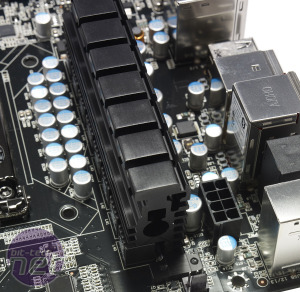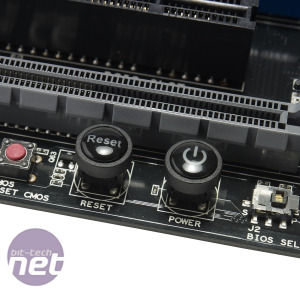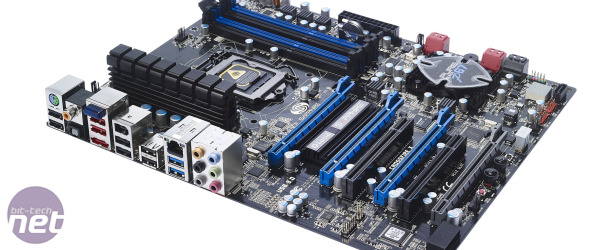Performance Analysis
Given its price and questionable balance of features (would you rather have a Lucid Hydra chip or a seventh expansion slot?) it’s not unfair to say that the Pure Black needed to distinguish itself in terms of raw performance to stand any chance of bagging a recommendation. It’s interesting then that the board did indeed distinguish itself, but in completely the opposite way to which we’d hoped.The Pure Black scored only 1,529 points when running at stock speed in our image editing test; almost a full 100 points slower than quick boards such as the Gigabyte Z68A-D3H B3 and the Asus Sabertooth P67.
This result was followed up by an even more disappointing one: the Pure Black was over 400 points (nearly 20 per cent) slower in our video encoding test than any other P-series motherboard we’ve seen.
Another poor result at stock speed in our multi-tasking test meant that the Pure Black ended up with a final score of 1,814 in our Media Benchmark suite. This is easily the worst result we’ve seen from an LGA1155 board, with less performance than even boards that are £60 cheaper.
Clearly something was up, so we had a root around and found that the Pure Black wasn’t allowing our Core i5-2500K CPU to Turbo Boost - the feature was disabled by default in the EFI. This is an epic oversight on Sapphire’s part, as Turbo Boost is excellent and completely safe to use. To clarify, our stock-speed test is exactly that, allowing well-designed boards to shine (remember Abit and its cheeky little default overclock?) and punishing boards that require extra work to set up.
The lack of Turbo Boost also explains why the board was so much slower in the video encoding test, as this is the most CPU-dependent of the three tests. The other two tests, on the other hand, are more system-wide benchmarks that stress different buses and subsystems of a PC, such as the memory and storage, as well as the CPU.
Given what we’d found, we were unsurprised when the Pure Black returned poor gaming performance at stock speed. Its minimum frame rate in Arma II of 69fps was 7fps behind the fastest result we’ve seen in that test, and meant that the Pure Black sat bottom of the table again.
The poor stock-speed results should be rounded off with a mention that, with the Pure Black, Turbo Boost is only enabled when you turn on Enhanced Intel Speed Step (EIST). As Turbo Boost is disabled by default, so is EIST, meaning that the CPU idles at full speed, wasting electricity and making your PC hotter and louder than necessary. If you have this board, enter the EFI and enable EIST (and therefore Turbo Boost) even if you don't plan to overclock it.
Overclocked Performance
At least there was some reprieve for the board when it came to its overclocked results. The results still weren’t great, though, largely because the Pure Black’s maximum stable overclock of 4.8GHz was a little less than the 4.9-5.1GHz that most the other boards we’ve tested managed.The overall Media Benchmark score of 2,602 was a good effort, but it was still the slowest result we’ve seen from an overclocked LGA1155 motherboard. Even cheaper boards such as the MSI P67A-GD53-B3 or the Asus P8P67-M Pro beat it by around 100 points. Gaming performance saw a good bump in the minimum frame rate too, but this was only good enough to push the Pure Black up to the stock-speed performance of most of the other boards we've tested.
Conclusion
We’ve been pretty hard on the Sapphire Pure Black P67 Hydra throughout this review, but for many reasons. The inclusion of the Lucid Hydra chip adds cost and removes the seventh expansion slot without adding much value. Are you really going to mix GeForce and Radeon graphics cards when AMD and Nvidia already have trouble supporting just their own products?Conspiracy theorists may suggest that Lucid Hydra is the only way that long time AMD ally Sapphire can get SLI support on its motherboards, and if that’s true then we can sympathise with the company’s position. Unfortunately, if Sapphire is looking to make headway in the motherboard market, it needs a simpler and cheaper solution to this problem - Lucid Hydra is not an adequate alternative to SLI certification from Nvidia.
Add to this the cost of the board, the Turbo Boost oversight and relatively poor performance even when overclocked, and it’s clear that the Pure Black is best avoided, especially for the £167.98 asking price. There is hope for Sapphire, however, as some inclusions on the board are welcome. We'd like to see more boards with the POST code readout that transforms into a CPU temperature monitor, for example.
-
Speed29 / 45
-
Features23 / 30
-
Value10 / 25


MSI MPG Velox 100R Chassis Review
October 14 2021 | 15:04












Want to comment? Please log in.